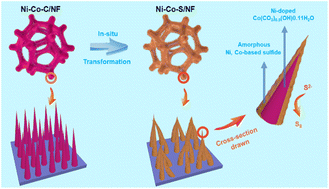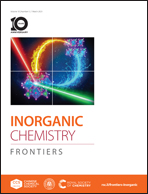Surface reconstructing hierarchical structures as robust sulfion oxidation catalysts to produce hydrogen with ultralow energy consumption†
Abstract
Replacing the oxygen evolution half-reaction by a sulfion oxidation reaction (SOR) with ultra-low theoretical oxidation potential and designing efficient SOR catalysts are promising strategies to decrease the energy consumption of electrochemical hydrogen production. Here, Ni-doped cobaltous carbonate hydroxide nanorod arrays (Ni-Co-C/NF) are used as unique pre-electrocatalysts for SOR. Ni-doped cobalt carbonate hydroxide in situ transforms into Ni, Co-based sulfides with a high degree of amorphization (Ni-Co-S/NF) during the SOR process. Ni-Co-S/NF achieves high SOR intrinsic activity, and just needs an ultra-low potential of 0.366 V vs. RHE to reach a current density of 100 mA cm−2. Meanwhile, a dissymmetrical acid–base coupled electrolytic system is designed for simultaneous hydrogen and sulfur production using Ni-Co-S/NF as the catalytic electrode. This well-designed system significantly decreases the energy consumption of hydrogen production, and can even generate extra electric energy at low current density. This work provides unique insights into an in situ reconstruction and dissymmetrical electrolyte, which will promote the fast development of hydrogen energy.

- This article is part of the themed collection: 2023 Inorganic Chemistry Frontiers HOT articles


 Please wait while we load your content...
Please wait while we load your content...